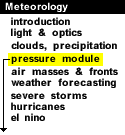
|

The weight of the air above an object exerts a force upon that object,
and this force is called pressure. Variations in pressure lead to the
development of winds that play a
significant role in shaping our daily weather.
The purpose of this module is to introduce
pressure, how it
changes with height and how it is represented on
weather maps. In addition, this module will
introduce high and
low pressure systems and their associated features.
The navigation menu (left) for this module is called "Pressure Module" and the menu items are arranged in a recommended sequence, beginning with this introduction. Click on the menu item of interest to go to that particular section. More details about the navigation system or the WW2010 web server in general are available About This Server.
| Sections |
Definition
Defines pressure and introduces its various units of measurement.
Pressure with Height
Isobars
High Pressure Centers
Low Pressure Centers
|
|


